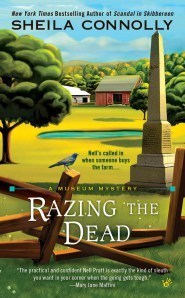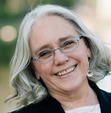Edith Maxwell's Blog, page 284
June 5, 2014
Wicked Fundraising Efforts
The Wickeds continue to celebrate Sheila Connolly’s book birthday for Razing the Dead. Today we’re talking about our best fundraising efforts, in honor of Nell Pratt and her many adventures in the Museum Mysteries. 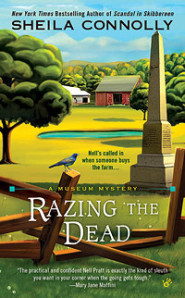
Liz: There’s something so gratifying about asking for money for a good cause. One of my favorite fundraising experiences was chairing a live and silent auction for an animal rescue group I worked with – we raised tons of money for the furries. My most recent experience, though, was the annual fundraising breakfast for Safe Futures, a domestic violence and sexual assault center where I’m a board member. We raised a record-breaking amount for the organization and it was so satisfying to be part of that.
Sherry: This is a twist on fundraising. When I lived and worked in Cheyenne, Wyoming I was asked to help with the marketing for a campaign called Schools for Cheyenne’s Future. We were trying to get a slight increase in property taxes to fund renovations. It’s not exactly a popular issue especially for people who no longer have kids in the school system. I managed, through the marketing campaign, to show how the schools were used for other events open to all. The evening the votes were counted a group of us sat around a TV watching as the votes trickled in. It passed by a landslide.
Barb: My admiration for people who raise funds for non-profits is boundless–mainly because I would be so incredibly bad at it. Good, highly productive fundraisers whose vision and passion are aligned with the organization they work for are as rare as hen’s teeth and should be treasured. A friend of mine once told me you should never start a rock band unless you’ve found your bass player, because the good ones are so rare. Same thing for non-profits and fundraisers.
Julie: Liz, as someone who runs a non-profit, your attitude it is my dream board member’s. StageSource does some fundraising efforts throughout the year, and we do have donors who help support us. And we contribute to some fundraisers as well–I was auctioned off for a lunch date recently! If anyone has a fun idea for a fundraiser for an arts service organization, I’m all ears!
Edith: I love donating naming rights. In fact, a woman bought naming rights to a character in ‘Til Dirt Do Us Part at at StageSource auction. I wrote her in as a farm subscriber, blah, blah. Then to my surprise she turned out to be an undercover DEA agent! The woman who bought the rights is delighted and has become one of my biggest fans. I did the same for the Merrimac River Feline Rescue Society at their annual auction last fall,
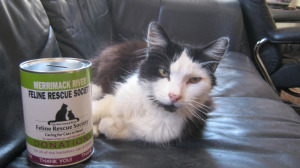
Birdie likes to help with the Amesbury donation cans.
which is incredibly well run and raises lots of bucks. They decided to feature my naming rights in the live auction and put me right up on the stage with auctioneer Randy Price (well-known local newscaster), with a massive photo of my book cover on the screen behind us. The rights went for something like $350! We all had fun, and the winner became an environmentalist schoolteacher in Farmed and Dangerous who even asks Cam out for a date. But I wouldn’t want to work at being a fundraiser full time. I even hate to accost strangers at a farmers’ market where I’m selling books to say, “Do you like mysteries?”
Readers, share fundraising stories in the comments below!
Filed under: Book Release, Group posts Tagged: cozy mystery, fundraising, Merrimac River Feline Rescue Society, Museum Mysteries, Razing the Dead, sheila connolly

June 4, 2014
Wicked Wednesday – Why We Can’t Wait to Read the Next Museum Mystery
On Wicked Wednesdays, we all weigh in on a subject. This week we are celebrating the  launch of Razing the Dead, the latest of Sheila Connolly’s Museum Mysteries, out this week. And today we’re talking about what we love best about these books by one of our favorite authors – and people!
launch of Razing the Dead, the latest of Sheila Connolly’s Museum Mysteries, out this week. And today we’re talking about what we love best about these books by one of our favorite authors – and people!
Liz: I love Sheila’s ability to weave culture, community, the past, present and a good mystery together. She’s a master of the craft and I can’t wait to see what trouble Nell and her FBI “partner” get into this time.
Jessie: I love the location of this series and the behind the scenes look into the world of museums. You always learn something interesting when you read Sheila’s books.
Barb: Since I once lived outside of and then went to college in Philadelphia, I love the setting of the Museum Mysteries, too. But what really draws me to them is the character of protagonist Nell Pratt. She’s got a serious career that’s more than a job, and I find that’s rare in cozies where people tend to be small business entrepreneurs, often with failed or disrupted careers behind them. I love watching Nell solve these mysteries, while balancing her work life (and her love life).

Philadelphia Friends worshipping, circa 1900
Edith: Sheila consulted me in advance about Quakers and the Testimony of Peace. I can’t wait to see where those inquiries ended up in her story. Philadelphia, of course, was founded by Friend William Penn, and it’s still the locus of American Quakerism. Nell is smart, and meets her challenges capably. I love this series.
Julie: As someone who works in the arts, and knows a few fundraisers, I love the conceit of this series. Sheila knows this world, and it shows. Very fun to have that POV on a protagonist.
Sherry: When I read a book by Sheila, I’m immersed in a whole new world and one I want to stay in. Her characters seem so real and I’d love to have Nell for a friend.
Readers: What do you like about this series? Any questions for wicked cozy Sheila?

Filed under: Book Release, Group posts Tagged: Museum Mysteries, Philadelphia, Quakers, Razing the Dead, sheila connolly, Society of Friends

June 3, 2014
Happy Book Birthday – Razing the Dead!
 Happy day to Sheila Connolly! The fifth Museum Mystery, Razing the Dead, releases today!
Happy day to Sheila Connolly! The fifth Museum Mystery, Razing the Dead, releases today!
Here’s what Sheila’s website says about the book:
“Between the challenges of her position as president of the Pennsylvania Antiquarian Society in Philadelphia and of taking her relationship with FBI Agent James Morrison to the next level, Nell Pratt has got her hands full. Nevertheless, when a powerful developer approaches the Society to make sure the old dairy farm he wants to level is not hiding any archeological or historical surprises that could derail the project, Nell decides to make time to personally accompany him to the proposed site.
But when they get to the property, they stumble upon a startling discovery—a body floating face-down in a pond. The dead man turns out to be an amateur history enthusiast, who may have uncovered secrets about the farm that got him killed. Now it’s up to Nell and Morrison to get to the bottom of things before there are more deadly developments…”
Woot! Let the champagne flow and the sales rack up.
Liz: Congrats, Sheila! Can’t wait to read, as is the case with all your books. Happy celebrating!
Jessie: This sounds like another great read, Sheila! And what a great cover!
Sherry: I don’t know how you do it, Sheila! But I can’t wait to read this — and of course my mom is waiting anxiously too!
Barb: Happy Book Birthday, Sheila–a 3x a year event for you! You must get tired of all that birthday cake.
Julie: Happy Book Birthday! I continue to be amazed at your work ethic–I can barely keep one book focused. Enjoy the day!
Edith: May the celebrations continue, and may this excellent series have a long and profitable life!
Filed under: Group posts Tagged: Philadelphia, Razing the Dead, sheila connolly

June 2, 2014
Balance
by Sheila Connolly
Rec ently I had dinner at a renowned restaurant with a big-name chef in a Boston suburb. Since this was sort of a celebration (yet another birthday, sigh), I opted for the Tasting Menu with Wine Pairings. In general this is something a chef puts together to showcase his (or her!) preferences and talents. This one did not disappoint: it was outstanding (and that wasn’t just the wine pairings talking!).
ently I had dinner at a renowned restaurant with a big-name chef in a Boston suburb. Since this was sort of a celebration (yet another birthday, sigh), I opted for the Tasting Menu with Wine Pairings. In general this is something a chef puts together to showcase his (or her!) preferences and talents. This one did not disappoint: it was outstanding (and that wasn’t just the wine pairings talking!).
But this is not a food blog. Being of analytical mind, after the meal I reviewed what I had eaten, trying to decide what unified the five dishes, and also trying to deduce what message the chef wanted us to take away. It came down to one word: balance.
I noticed that both my husband and I tasted the individual components of each dish first—most often the sauce, then the separate elements (protein, vegetables, starches). They were uniformly tasty. But something magical happened when we took the first bite that combined all the elements—and that’s where the genius of the chef showed. Everything worked together to create a sum that was better than any of the parts taken on their own.
The same thing applies to writing. I’m sure we’ve all read books in which the plot is brilliant but the characters are wooden; or the characters are endearing or frightening but we’re left wondering just what the heck they were all doing together on the page; or the language was beautiful and sometimes even stopped us as we admired a particular turn of phrase, but the story was flat-out silly. Sometimes the parts are enough to keep us reading—we’ll forgive the weaker elements because the stronger ones are so good.
But in the really good books—the ones you remember for a long time, the ones you try to persuade your friends to read—all the elements merge seamlessly. You believe in the characters, you don’t stop to question the twists and turns of the plot, and the language doesn’t intrude upon the story but reinforces it. Not every writer can pull this off. There’s no tidy formula, no algorithm that tells you, “oh, I haven’t mentioned any emotion lately—better have someone react” or “my protagonists have been doing an awful lot of talking in the last three chapters—maybe it’s time for something to happen.”
Yes, we as writers do think about things like that, but it’s not like we work with a chart (okay, maybe some people do, but not me) with columns labeled “Romance” and “Plot Point” and “Explanation” and so on. The ones who write like that we call Plotters; the ones who fly by the seat of their pants and make it up as they go we call Pantsers.
But the point is, whichever approach you (the writer) choose to take—structured or intuitive—you have to achieve a balance, so that all the parts weave together, so well that the reader doesn’t even notice. And that’s the art and the mystery of writing a good book. We all aim for it, but there’s no guarantee that we’ll succeed. But we keep trying!
Coming June 3rd (yes, that’s tomorrow!). Nell Pratt tries to balance her job, raising money, nurturing her still-new relationship with an FBI agent, and solving yet another murder.
For more details, see www.sheilaconnolly.com
Filed under: Sheila's Posts Tagged: Museum Mysteries, Razing the Dead, sheila connolly

May 30, 2014
Organic Growing, Organic Writing
Edith here, delighted to have ‘Til Dirt Do Us Part - my second Local Foods mystery – out and available! And huge thanks to the Wickeds and so many other fans for helping me celebrate all week.
My protagonist in the Local Foods mysteries, Cam Flaherty, is an organic farmer. She’s working hard to get her new farm certified, and has to confront several challenges to that  goal.
goal.
As you might know by now, I was a certified-organic farmer myself twenty years ago, and I’m an organic gardener now. I also, for the most part, write organically. But what does writing organically mean?
Some mystery writers plot out their stories in advance. They write outlines, create spreadsheets and timelines, produce detailed synopses. Others start with a few 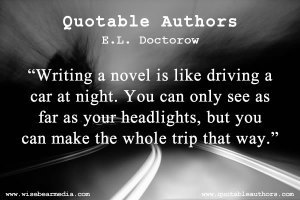 characters, possibly an idea for the crime, an inkling of the villain, a vision of the victim. Then they follow these people around and write down what they do. This has been called writing by the seat of your pants. Writing organically. Writing into the headlights. Writing organically.
characters, possibly an idea for the crime, an inkling of the villain, a vision of the victim. Then they follow these people around and write down what they do. This has been called writing by the seat of your pants. Writing organically. Writing into the headlights. Writing organically.
My path of least resistance is to write organically, although these days my editor requires me to turn in a synopsis of the next book before I write it.
So how does writing organically compare with growing organically? When I garden, I set  up the best soil I can. I add lots and lots of organic matter: compost, wood ash, decomposed leaves, seaweed, whatever I can find. I work the soil only when it is dry, so it doesn’t destroy the natural structure of air and particles under the surface. I either raise my own seedlings or or buy them from a local farm, and plant only organically raised seeds. I water my baby plants only when they’re dry and always when they’re dry. And then I follow my plants as they grow. I prune off unnecessary suckers on the tomato vines.
up the best soil I can. I add lots and lots of organic matter: compost, wood ash, decomposed leaves, seaweed, whatever I can find. I work the soil only when it is dry, so it doesn’t destroy the natural structure of air and particles under the surface. I either raise my own seedlings or or buy them from a local farm, and plant only organically raised seeds. I water my baby plants only when they’re dry and always when they’re dry. And then I follow my plants as they grow. I prune off unnecessary suckers on the tomato vines. 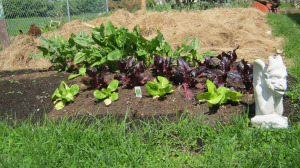 I harvest the best cucumbers and Asian eggplants and put anything that’s damaged or diseased in the compost. I cut a dinner’s worth of salad, knowing the mizuna, arugula, and baby lettuces will regenerate for another night’s meal.
I harvest the best cucumbers and Asian eggplants and put anything that’s damaged or diseased in the compost. I cut a dinner’s worth of salad, knowing the mizuna, arugula, and baby lettuces will regenerate for another night’s meal.
Same with writing. I prepare myself by taking online courses, studying excellent writing, reading constantly. I create my writing  space, both physical and mental, so I’m ready for unimpeded creativity. I churn out a first draft, bringing myself back to the garden of my story over and over again. And then I prune. I weed. I train the vines of my scenes so they work, so the plot is at once complete, fair to the reader, and also a guessing game. I up the suspense, enrich the characters’ motivations and secrets, and also leave a few things unsaid for the dinner in the next book in the series.
space, both physical and mental, so I’m ready for unimpeded creativity. I churn out a first draft, bringing myself back to the garden of my story over and over again. And then I prune. I weed. I train the vines of my scenes so they work, so the plot is at once complete, fair to the reader, and also a guessing game. I up the suspense, enrich the characters’ motivations and secrets, and also leave a few things unsaid for the dinner in the next book in the series.
Or at least that’s my goal, both in the garden and in the book.
What’s your gardening method? Your writing method? Is there any parallel with reading?
Filed under: Craft, Edith's posts, Farming Tagged: 'Til Dirt Do Us Part, Kensington Publishing, organic farming, organic gardening, organic writing, pantser, plotter, writing into the headlights

May 29, 2014
It’s Farmers’ Market Season!
We’re celebrating Edith’s book birthday all week as ‘Til Dirt Do Us Part makes its way 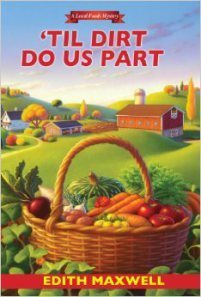 into the world. As part of our festivities, the Wickeds are talking about farmers’ markets and our favorite items to take home from them. We might even share a recipe or two!
into the world. As part of our festivities, the Wickeds are talking about farmers’ markets and our favorite items to take home from them. We might even share a recipe or two!
Liz: There’s an awesome farmers’ market a couple towns over from me, the Coventry Farmers’ Market, known throughout New England because of its sheer size and experience. It’s like going to a county fair. I love it because the dogs get to go, and in addition to fruits and veggies and all kinds of other treats, they often have other groups there doing educational things. One weekend last summer a greyhound rescue brought some of their dogs, and another weekend some alpacas came to visit. As far as bringing something home, fresh berries, without a doubt. Raspberries, blackberries, strawberries, blueberries, all of the above. I’m a fresh berry junkie – love them to eat and to put in my smoothies.
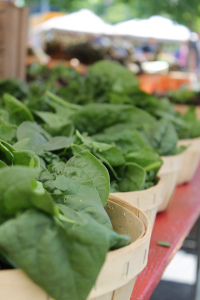 Barb: In summer for us, it’s the Boothbay Farmer’s Market on the green in Boothbay, Maine. It’s been open for the season for two weeks now and Bill and I are thrilled because fresh produce can be hard to get on the peninsula–not to mention the local meat, baked goods, cheeses and other delicious treats. But I also wanted to mention Russo’s in Watertown, MA. I famously don’t grocery shop, but over the years, I have made an exception for Russo’s. It’s not technically a farmer’s market. Originally a small retail outlet for a restaurant wholesale business, it’s expanded over the years, yet the aisles can still be jammed with shoppers. What I love is it’s a multi-ethnic, multi-national shopping experience. “What do you do with that?” a little old Italian lady will ask, spying an unfamiliar squash in a young Ethiopian woman’s cart. “Oh, it’s for a stew. You peel it…” This goes on all the time at Russo’s, which is why I enjoy the place so much.
Barb: In summer for us, it’s the Boothbay Farmer’s Market on the green in Boothbay, Maine. It’s been open for the season for two weeks now and Bill and I are thrilled because fresh produce can be hard to get on the peninsula–not to mention the local meat, baked goods, cheeses and other delicious treats. But I also wanted to mention Russo’s in Watertown, MA. I famously don’t grocery shop, but over the years, I have made an exception for Russo’s. It’s not technically a farmer’s market. Originally a small retail outlet for a restaurant wholesale business, it’s expanded over the years, yet the aisles can still be jammed with shoppers. What I love is it’s a multi-ethnic, multi-national shopping experience. “What do you do with that?” a little old Italian lady will ask, spying an unfamiliar squash in a young Ethiopian woman’s cart. “Oh, it’s for a stew. You peel it…” This goes on all the time at Russo’s, which is why I enjoy the place so much.
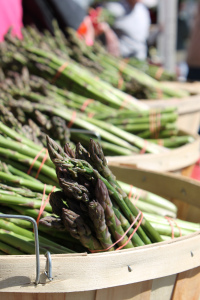 Julie: I live in Somerville, MA, and love that there are so many farmer’s markets around me. Harvard Square has one during the week. Union Square has one on Saturdays. And I am even thinking about getting a half share in a CSA. My favorite farmer’s market finds, though? Much as I love, love, love in-season vegetables, and really love summer crops, I enjoy finding the other items at the market, like jams and jellies, or local chocolates. Supporting local is so important for so many reasons, and farmer’s markets are a great way to discover local businesses. And PS, I am going to Russos soon!
Julie: I live in Somerville, MA, and love that there are so many farmer’s markets around me. Harvard Square has one during the week. Union Square has one on Saturdays. And I am even thinking about getting a half share in a CSA. My favorite farmer’s market finds, though? Much as I love, love, love in-season vegetables, and really love summer crops, I enjoy finding the other items at the market, like jams and jellies, or local chocolates. Supporting local is so important for so many reasons, and farmer’s markets are a great way to discover local businesses. And PS, I am going to Russos soon!
Sherry: Having lived all over the country while Bob was in the Air Force I’ve been to a lot of farmers markets. In Cheyenne, Wyoming they roasted chili peppers in huge rotating wire baskets  over open flames. When we lived in San Pedro, CA I ate so many strawberries I’m surprised I didn’t turn red. In Monterey every Tuesday night Alvarado street downtown was closed. And like with Liz, it was more like a festival than a farmers market. I’ve never seen such fresh produce. In Bedford, MA we found the most amazing tomatoes. And now in Virginia we buy all kinds of produce and oh, the bakery that brings bread, delicious.
over open flames. When we lived in San Pedro, CA I ate so many strawberries I’m surprised I didn’t turn red. In Monterey every Tuesday night Alvarado street downtown was closed. And like with Liz, it was more like a festival than a farmers market. I’ve never seen such fresh produce. In Bedford, MA we found the most amazing tomatoes. And now in Virginia we buy all kinds of produce and oh, the bakery that brings bread, delicious.
Edith: I love going to the farmers’ market, and to local farm stands. It’s a little different, though, when you’re trying to sell rather than looking to buy. I remember putting out crisp, pristine heads of lettuce and watching them wilt in four hours of sun. The next week I got a market umbrella! At one market I was surrounded by bakers and other giving out tasty samples, so I decided to offer samples of tender arugula. It being 1992, nobody had any idea of what that “exotic” green was. But greens lovers always bought a bunch after trying it.
Now I’m trying to sell books at market 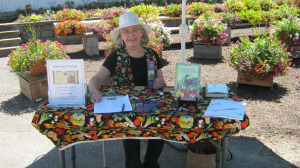 instead of produce. Here I am last year at Cider Hill Farm, our local orchard and vegetable farm, and the farm that inspired the fictional farm-to-table dinner described in the beginning of ‘Til Dirt Do Us Part. I’ve signed up for one market a month through September all over the north-of-Boston region. Wish me luck!
instead of produce. Here I am last year at Cider Hill Farm, our local orchard and vegetable farm, and the farm that inspired the fictional farm-to-table dinner described in the beginning of ‘Til Dirt Do Us Part. I’ve signed up for one market a month through September all over the north-of-Boston region. Wish me luck!
Jessie: Instead of farmers’ markets I usually head for farm stands. I live in a really rural area and am lucky to be surrounded by orchards and blueberry fields as well as farms that raise vegetables. I particularly like McKenzie’s Farm for their delicious tomatoes and cider doughnuts. In the fall we always buy a crate of apples from Kelly Orchards to make cider with friends and family on an antique press.
Readers: What’s your favorite market or farm stand? Any good recipes? Best or worst buys?
Filed under: Book Release, Farming, Group posts Tagged: 'Til Dirt Do Us Part, Edith Maxwell, farmers' markets, farming, local foods mysteries, produce, summer

May 28, 2014
Wicked Wednesday: The Cam Flaherty Fan Club
On Wicked Wednesdays, we Wickeds weigh in on a subject. This week we are 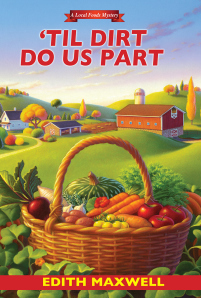 celebrating the launch of ‘Til Dirt Do Us Part, the latest in the Local Foods mystery series. So the question is, what do we like about the protagonist of the series, Cam Flaherty?
celebrating the launch of ‘Til Dirt Do Us Part, the latest in the Local Foods mystery series. So the question is, what do we like about the protagonist of the series, Cam Flaherty?
Jessie: I like that Cam’s spunky and is not afraid to get her hands dirty both literally and figuratively. She works hard to grow her business and to build a community around it.
Liz: Cam’s a cool lady – she’s not afraid to take risks, she’s a fierce believer in local farms and local foods, and she’s dedicated to clean eating. She’s also got no fear – and I totally respect that!
Sherry: I love Cam because Edith’s passion for local foods and organic farms shines through Cam. Cam’s an introvert and has to challenge herself to face that issue so her farm will be a success. It adds another layer of depth to Edith’s books.
Barb: I like the challenge Edith has set for herself as a writer with Cam. Cam is an introvert and a computer programmer who’s lived most of her life in her head. In the Local Food Mysteries, Cam moves from the intellectual realm to the intensely physical, and from a solitary pursuit to one where she can only get by with a little help from her friends–she has to live in and rely on her community. In some ways it’s the ultimate fish out of water story, but in others, it’s a recognizable and believable journey.
Julie: I love that Cam is carrying the family tradition forward. She is farming her uncle’s land, and is determined to make a go of it. That says so much about her character, and it helps support her searches for justice.
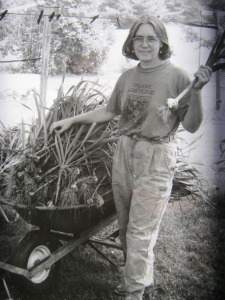 Edith: <Blowing kisses to my blogmates: mwah!> I created Cam twenty years ago when I was a farmer myself, and I wanted a protagonist who wasn’t anything like me. So she’s way taller, younger (so now she’s WAY younger), a geek good with numbers and data where I’m more of a story/words type, single, and an introvert. I have introverted aspects, but I also love being among people I know well, and am just a little bit famous for getting down on the dance floor.
Edith: <Blowing kisses to my blogmates: mwah!> I created Cam twenty years ago when I was a farmer myself, and I wanted a protagonist who wasn’t anything like me. So she’s way taller, younger (so now she’s WAY younger), a geek good with numbers and data where I’m more of a story/words type, single, and an introvert. I have introverted aspects, but I also love being among people I know well, and am just a little bit famous for getting down on the dance floor.
And I think it’s very cool that others see parts of Cam, and Cam in the books, that I had no idea I was writing, or that emerged as part of the stories with no intention on my part.
Readers: What’s your view of this tall, somewhat awkward new farmer? How’s she been doing so far? Where would you like to see her going, in romance, in farming, in life?
Filed under: Farming, Wicked Wednesday Tagged: 'Til Dirt Do Us Part, Cam Flaherty, Edith Maxwell, friends, geek, introvert, Kensington Publishing, local foods mysteries, organic farming, Wicked Wednesday

May 27, 2014
Happy Book Birthday — ‘Til Dirt Do Us Part
 Today we celebrate the second book of Edith’s Local Foods Mystery series, ‘Til Dirt Do Us Part. Booklist has this to say about ‘Til Dirt Do Us Part: “The organic-farming backdrop ably supports a twisted and timely plot. There are plenty of farming-based cozies on the market today, but this one stands out in what is becoming a crowded field.“
Today we celebrate the second book of Edith’s Local Foods Mystery series, ‘Til Dirt Do Us Part. Booklist has this to say about ‘Til Dirt Do Us Part: “The organic-farming backdrop ably supports a twisted and timely plot. There are plenty of farming-based cozies on the market today, but this one stands out in what is becoming a crowded field.“
Sherry: Happy book birthday, Edith! I’m so excited to read the final version of the second book in this series! Have a fabulous day!
Liz: Yay!! I’ve been waiting for ‘Til Dirt for what seems like forever! I can’t wait to read about the rescue chickens :)
Jessie: Happy Book 2 Birthday, Edith! I hope you are doing something fabulous to celebrate. I agree with Liz about the chickens. They sound like such fun.
Barb: Happy Book Birthday, Edith! It will be such a pleasure to return to Westbury and find out what’s up on Cam’s farm.
Julie: Happy Book #2! What a perfect time of year to read about Cam’s latest adventures. Congratulations!!!
Thanks for helping us celebrate the arrival of ‘Til Dirt Do Us Part!
Filed under: Group posts Tagged: 'Til Dirt Do Us Part, Cam Flaherty, local foods mysteries, Local Foods Series

May 26, 2014
Web Series vs Mystery Novel Writing — Collaboration and Craft
Sherry Harris in sunny Northern Virginia
 I met Kathryn O’Sullivan the day I went to my first Chesapeake Chapter meeting of Sisters in Crime. Kathryn’s most recent book, Murder on the Hoof, came out last week. Thanks so much for joining us today, Kathryn!
I met Kathryn O’Sullivan the day I went to my first Chesapeake Chapter meeting of Sisters in Crime. Kathryn’s most recent book, Murder on the Hoof, came out last week. Thanks so much for joining us today, Kathryn!
Thanks, Sherry Harris, for inviting me to do a guest blog! Since I write THURSTON, a Western web series, and the Colleen McCabe mystery series, Sherry thought it might be fun for me to compare writing a web series with writing novels. I quickly realized that I could write an entire chapter! However, I finally settled on two areas – collaboration and craft.
Collaboration
Writing a web series (think online television with shorter episodes) and writing a novel both involve collaboration, and this collaboration influences my writing. The script for a web series is the beginning of the creation of the final product (the episode that airs) – it is not the final product. My script for an episode is not fully realized until actors, directors,costumers, designers, editors, etc. have brought their unique creative talents to the story. When I see an actor do something interesting with a character while working with the director, I make a note to incorporate that into future scripts. In the editing room, lines or scenes are cut because they’re no longer necessary or serve the story. A score can add tension or lighten the mood. The story evolves as each person contributes to the process. When writing a web series, you shouldn’t expect your script to turn out exactly as you wrote it. You must be willing to give up the idea of controlling everything. If you’re open to collaboration, you’ll discover that your story often ends up better than you had initially written.

Kathryn with the cast and crew of Thurston.
Writing a novel also involves collaboration. For my web series it is script first, collaboration second. For my novel it is collaboration first, book second. The book sitting on the shelf is the final product. Whether it’s your writing group, a close friend, your husband or a neighbor you begged to read early drafts, when you invite people to give you feedback on your work they are collaborating. Add your editor’s, agent’s, and copyeditor’s input and you quickly appreciate how many collaborators you have. Yes, I’m still the one writing the book; but many people along the way influenced how it turned out. They may not be collaborators as obvious as actors and directors but they are just as crucial to my final product.
Craft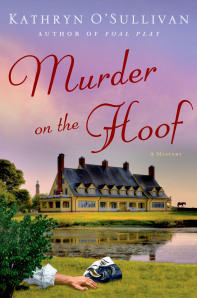 Now let’s talk about the technical aspects of writing. Both the web series and books let me tell an ongoing story that allows my characters to evolve and change; both force me to think visually in terms of how I describe the action; and both should have tight dialogue that reveals something about character or moves the plot forward.
Now let’s talk about the technical aspects of writing. Both the web series and books let me tell an ongoing story that allows my characters to evolve and change; both force me to think visually in terms of how I describe the action; and both should have tight dialogue that reveals something about character or moves the plot forward.
So what’s different? One of the things I can’t do when writing a web series script is write a character’s thoughts – anything “in the head.” Why? Because an audience can’t see a thought while watching the show. If I want an audience to know what a character is thinking or feeling I need to reveal that by describing what the character does (an action/behavior) or says (dialogue).
Another difference is the verb tense. Screenplays are written in the present tense. I write the action as if it is happening right now. Most books, however, are written in past tense. This was a definite adjustment for me. The length of sentences is also different. Screenplays tend to have terse sentences. It helps them “read” faster. I was so used to writing short sentences that my book editor had to tell me to vary my sentence length and structure! Also, with the THURSTON scripts, I’m appealing to two senses – sight and sound – since that’s how an audience will experience the show (unless, of course, they have a scratch-n-sniff card). When writing fiction I can also explore smell, touch, and taste. The final difference is the consideration of cost. Most writers don’t have to think about this but, because I’m also a producer of THURSTON, when I’m writing I’m always thinking about the budget. If I write a horse into a scene, that costs money. If I write a lot of locations or additional characters or effects, that costs money. But with a novel, I have incredible freedom. I can have a house explode, car chases, and as many characters – and horses – as I want, and they’re all free!
The bottom line is whether you’re writing a web series, novel, short story, screenplay or play, storytelling is storytelling. No matter the form or genre, we’re all interested in stories that have a main character we can root for as she or he struggles to overcome seemingly insurmountable obstacles in pursuit of a goal. We writers do this with collaboration, an understanding of the craft, and so much more. Happy reading and writing!
Kathryn O’Sullivan’s debut FOAL PLAY, a cozy set in North Carolina’s Outer Banks featuring feisty Fire Chief Colleen McCabe, won the 2012 Malice Domestic Best First Traditional Mystery Novel Competition. MURDER ON THE HOOF is the second book in the series. She is a playwright, co-executive producer/creator/writer of the Western web series THURSTON, and a theatre professor at Northern Virginia Community College. Kathryn lives in Virginia with her husband, an award-winning director and cinematographer, and their rescue cat, Oscar.
Websites: www.kathrynosullivan.com, www.thurston-series.com
Filed under: Guest posts Tagged: Chessie Chapter of Sisters in Crime, Collaboration and Craft, Colleen McCabe mystery series, Kathryn O'Sullivan, Murder on the Hoof, Thurston, Western Web series

May 23, 2014
Building a Character’s Family
Edith, North of Boston
I’m delighted to welcome my former teacher and one of my first author friends today, 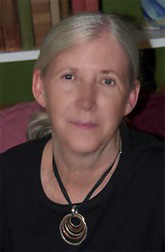 Susan Oleksiw. I love both of Susan’s series. Her Anita Ray mystery series make you feel like you were plopped directly into southern India, and her Mellingham series lets us see deep into Joe Silva’s life. Take it away, Susan!
Susan Oleksiw. I love both of Susan’s series. Her Anita Ray mystery series make you feel like you were plopped directly into southern India, and her Mellingham series lets us see deep into Joe Silva’s life. Take it away, Susan!
Building the Protagonist’s Family
One of the best parts of writing the cozy is building the protagonist’s family. I write two traditional series, one set in a small New England town, which I’ve named Mellingham, and the other set in South India at a tourist resort. The lead characters in both series have families but there the similarity ends.
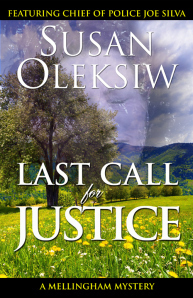 Chief of Police Joe Silva is the third of seven children in a large Portuguese family, and the first to move away from his hometown. He remains close to his family, but wants to make his own life. A bachelor for many years he falls for Gwen McDuffy, who has recently moved to Mellingham in the third book, Family Album. Gwen is the ostensible foster mother of two young children, Jennifer and Philip. By the fifth book, A Murderous Innocence, Joe and Gwen are living together and becoming a family. Joe’s parents and siblings take to Gwen right away, and as much as she comes to love them, she is intimidated by the sheer size of his family and their exuberance over the smallest matters, in Last Call for Justice. More changes are in store for Joe and his beloved, but right now I enjoy exploring their relationship in short fiction before I move on to the next step in their relationship in the seventh novel.
Chief of Police Joe Silva is the third of seven children in a large Portuguese family, and the first to move away from his hometown. He remains close to his family, but wants to make his own life. A bachelor for many years he falls for Gwen McDuffy, who has recently moved to Mellingham in the third book, Family Album. Gwen is the ostensible foster mother of two young children, Jennifer and Philip. By the fifth book, A Murderous Innocence, Joe and Gwen are living together and becoming a family. Joe’s parents and siblings take to Gwen right away, and as much as she comes to love them, she is intimidated by the sheer size of his family and their exuberance over the smallest matters, in Last Call for Justice. More changes are in store for Joe and his beloved, but right now I enjoy exploring their relationship in short fiction before I move on to the next step in their relationship in the seventh novel.
In the Anita Ray series, Anita lives with her Auntie Meena, her mother’s younger sister, at 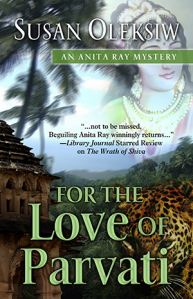 her aunt’s tourist hotel. Meena’s husband died young, and she is left with the hotel and a daughter who would rather live high in America. Anita’s mother is South Indian and her father American, but she has no interest in living in the States, which she is barely knows. Auntie Meena sees in Anita the perfect opportunity to be a fully engaged mother, finding her a suitable husband, introducing her to the “right” sort of people to tempt her away from photography, and proving to her older sister that she is a good parent, in the third in the series, For the Love of Parvati.
her aunt’s tourist hotel. Meena’s husband died young, and she is left with the hotel and a daughter who would rather live high in America. Anita’s mother is South Indian and her father American, but she has no interest in living in the States, which she is barely knows. Auntie Meena sees in Anita the perfect opportunity to be a fully engaged mother, finding her a suitable husband, introducing her to the “right” sort of people to tempt her away from photography, and proving to her older sister that she is a good parent, in the third in the series, For the Love of Parvati.
As a writer of mysteries I spend a lot of time working out plot lines for each book, but equally important for readers of the two series are developments in the characters’ lives. Joe and Anita grow, and their families and personal lives expand and deepen. I never know where their personal lives are going to go, but this is definitely one of the best parts of writing a series.
Susan Oleksiw writes the Anita Ray series featuring an Indian American photographer living at her aunt’s tourist hotel in South India (Under the Eye of Kali, 2010, The Wrath of Shiva, 2012, and For the Love of Parvati, 2014). She also writes the Mellingham series featuring Chief of Police Joe Silva (first introduced in Murder in Mellingham, 1993). Susan is well known for her articles on crime fiction; her first publication in this area was A Reader’s Guide to the Classic British Mystery. Her short stories have appeared in Alfred Hitchcock Mystery Magazine and numerous anthologies. Susan lives and writes outside Boston, MA.
Readers: Ask Susan a question! Curious about India? Or the life of Joe Silva? She’ll stop by today and answer.
Filed under: Guest posts Tagged: Anita Ray, Murder in Mellingham, Susan Oleksiw


